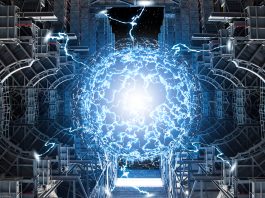Through research and development, ANItA’s mission is to generate knowledge-based decision support to efficiently implement new nuclear power technology in Sweden.
The current Swedish nuclear power programme was developed in the sixties and fully implemented in the seventies and eighties. There were several reasons for this programme’s development, with an important one being the reduction of Sweden’s heavy dependence on fossil fuel imports for increased national security. Another was to reduce emissions of acidifying substances into the atmosphere. A third reason was the realisation that an increasingly expansive industrial sector needed to be supported in terms of energy without using the last remaining rivers in the north for hydropower production. One reason that probably lay in the background was to show the outside world that Sweden could develop, construct, and build high-tech reactors, thus adding value to the export industry.
To enable this development in a country with a relatively small population, close co-operation between the state, industry and academia was recognised as a determining factor. As a result, nine of the twelve reactors that have operated in Sweden were of Swedish ASEA design and manufactured with virtually only Swedish supply chains.
In recent years, the need for new nuclear power in order to meet the national environmental and climate goals has become increasingly apparent. It seemed like a good idea to recreate at least parts of the strategy used in the sixties, where state, industry, and academia once again merge and co-ordinate their resources for a common goal. This is where ANItA comes into the picture.
The Academic-industrial Nuclear technology Initiative to Achieve a sustainable energy future (ANItA), was conceptualised in 2021 and began operating in 2022. ANItA is a collaboration platform currently consisting of: Uppsala University (host), Royal Institute of Technology (KTH) and Chalmers as academic partners. The industrial partners are: Vattenfall, Uniper, Fortum, Westinghouse and Studsvik Nuclear. The state is represented by the Swedish Energy Agency, with Swedish and Finnish regulators, and Women in Nuclear as observers.
Through research and development, ANItAs mission is to generate knowledge-based decision support that facilitates efficient and timely implementation of new nuclear power technology in Sweden, particularly light-water small modular reactors (SMRs). Part of this mission is also to secure and develop the important supply of expertise in the nuclear power technology field. The collaboration also aims to facilitate a rational debate in society on the role nuclear power has in addressing environmental and climate issues while keeping high welfare ambitions intact. Between 2022 and 2026, ANItA is funded with one third each from industry, academia and the Swedish Energy Agency, and the total budget amounts to approximately €8m during these first five years.
To address the different aspects of the mission, a joint research portfolio was developed that met the interests of both industry and academia and was in line with the analyses carried out concerning the requirements of implementing a new reactor technology. The resulting research portfolio currently consists of 14 projects comprising research and development work within technical and non-technical subjects. The projects are staffed with PhD students and postdoctoral researchers with supervision and senior participation from both the academy and industry. In this context, it is important to point out that ANItA is not involved in the design or construction of SMRs. Instead, it relies upon relevant information from the current reactor suppliers to reach ANItA to establish realistic scenarios for the research and development work.
The project portfolio
ANItAs project portfolio is divided into five research areas according to:
- A. SMR technologies and applications
- B. SMR-specific core, fuel, and operation
- C. SMR-specific reactor safety and safety systems
- D. Fuel cycles
- E. Deployment of new nuclear technology in Sweden
Research areas A-D cover a broad range of technical subjects relevant to light-water SMR utilisation. In brief terms, the projects deal with the following issues:
- Optimised chemistry for LWR SMRs
- Structural materials issues
- Fuel assembly and core design optimisation for SMRs
- Novel reactor monitoring techniques
- Novel approaches to nuclear safeguards
- Experimental methods for accelerating fuel development
- Recycling of spent nuclear fuel
- Applications beyond electricity generation
- Studying the role of SMRs in hybrid energy systems
- Design basis and beyond design basis scenarios, passive safety systems
While research areas A-D cover typical technical topics in nuclear engineering, research area E covers non-technical subjects directly impacting the implementation of SMRs and is therefore worth a brief review here. Research area E is divided into two projects, each dealing with the prerequisites for implementing SMRs in Sweden.

Implementation of SMRs and effects of serial production on the management of plant projects
The project includes studies on the mitigation of risks in SMR projects with, and risks related to, the construction schedule and budget emphasised here. The business case of SMRs relies heavily on serial production to premanufacture systems, components, and structures as much as possible in factories and then install them on-site, i.e., going from a ‘constructed on-site’ mindset towards ‘installed on-site.’ Such a shift may save costs and ensure that the project can be carried out on schedule and budget.
However, it requires new types of projects and financing models, including the roles and responsibilities of project parties. The benefits of serial production have been proven in other industry sectors, e.g., the shipping and aviation industries, and the experience gathered should be transferred to the nuclear industry. How to do this in an efficient and timely manner is one question to be answered within this research project.
Regulatory perspectives and licensing
To fully exploit the potential of SMRs, for local power and heat generation near end users, it is necessary to consider the location of the plants on untraditional sites. Now, virtually all infrastructure projects in Sweden are hampered by lengthy environmental assessment processes, which apply largely to new nuclear power. Therefore, changes in the law are paramount for the successful introduction of SMRs. Identification of necessary changes and how they correlate to Swedish and EU law will be researched, and proposals for changes in the legislation will be provided.
Successful licensing of SMRs is also needed before deployment. Swedish licensing has hitherto focused on power reactors individually, with separate licensing procedures for each unit. If a large number of identical units are to be installed at multiple sites, it makes sense to re-organise the licensing process into a generic phase with a type approval in a first phase, followed by a second phase restricted to site-specific issues. This would, however, challenge the current permitting processes used in Sweden, and this project aims to find viable ways to address this issue.
The types of challenges outlined above are not unique to Sweden. By addressing current and future requirements and safety standards, the activities within this research project aim to contribute to reducing possible risks and licensing difficulties at the early phase of SMR implementation in Sweden and potentially in other countries.
The required effort to carry out all the ANItA projects is significant. In fact, it is larger than stakeholders can generally manage, and the project requires a range of competencies that no one stakeholder alone can bring. ANItA’s main value lies in gathering and co-ordinating Swedish nuclear research, where a wide range of research and engineering expertise can be gathered under one umbrella and work coherently.
The research projects started in autumn 2023, and the first results are expected to be published in various peer-reviewed journals after the coming summer. In addition, project results and reports will be published on the ANItA website as soon they are available.
Additional research on nuclear power technology
At present, political and public opinion is in favour of introducing new nuclear power in Sweden. However, due to several decades of debate about nuclear power’s supposed dangers, high costs, etc., there are still doubts about new applications and the potential location of SMRs in people’s neighbourhoods. The societal aspects of implementing SMRs are one highly relevant field of research not yet covered by ANItA. Work is ongoing to incorporate researchers in social sciences into ANItA with the aim of creating an additional research area to the portfolio.
For completeness, it is worth mentioning that besides ANItA, there are two other research centres that encompass nuclear technology in Sweden. The Centre for Nuclear Technology (SKC), hosted by KTH, deals primarily with research connected to the current reactor fleet in Sweden. The Swedish Academic Initiative on Nuclear Technology research (SAINT) at Chalmers has a broader scope and largely comprises work within radiation sciences. Finally, although not a formal centre, it contributes to Swedish nuclear competence.
The Sunrise project at KTH is funded by the Swedish Energy Agency.
Conclusion
The research projects of ANItA have been in full operation since summer 2023, and the first results are about to be published in scientific journals and at conferences. Besides the research and development work, ANItA has also been represented in various public meetings, symposia, and mass media platforms to be available to society on issues related to nuclear power technology in general, and SMRs in particular. There is increased interest from new stakeholders to join ANItA. Since ANItA is now recognised at the highest political level in Sweden, it seems reasonable to say that the ANItA concept has been successful in relation to its mission.
Please note, this article will also appear in the 18th edition of our quarterly publication.









